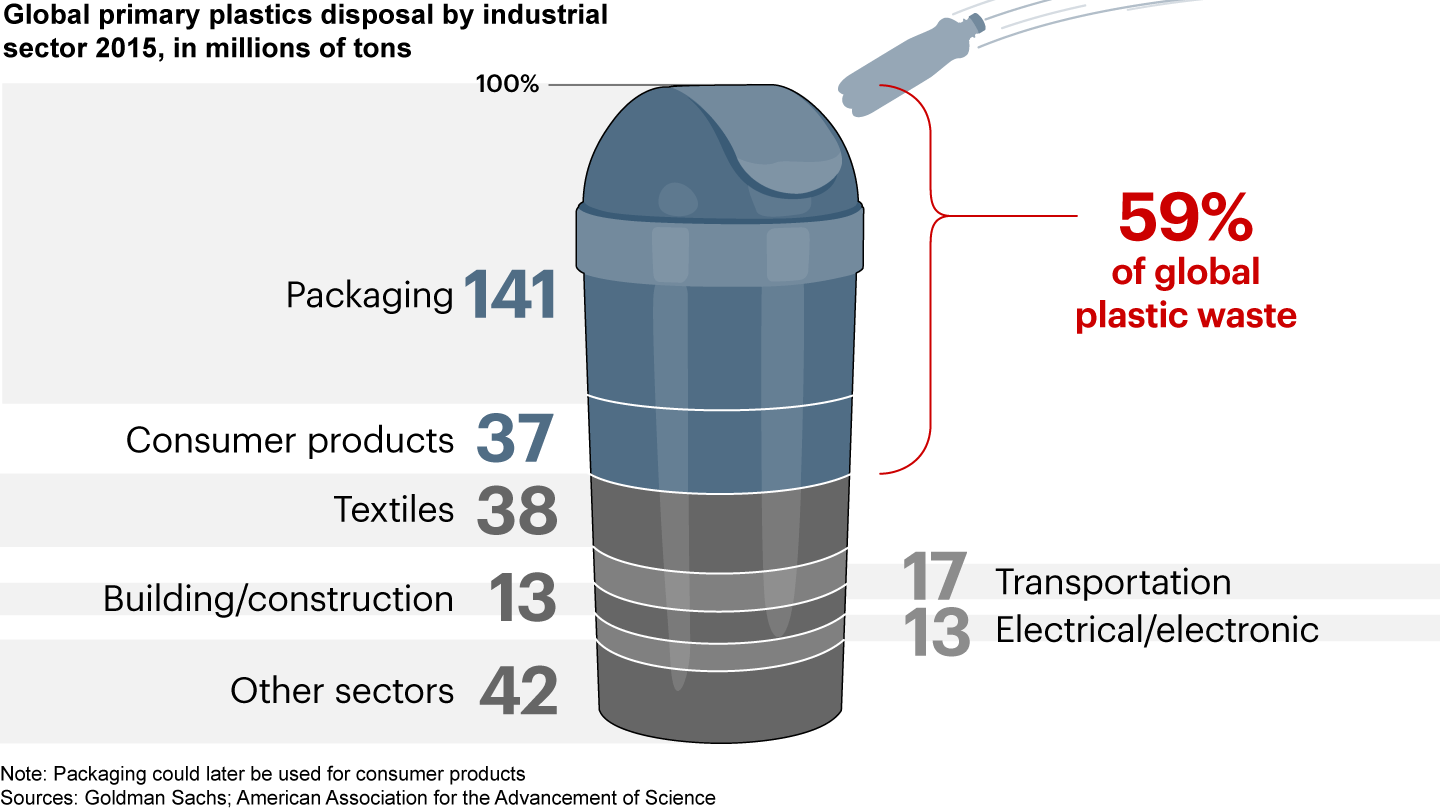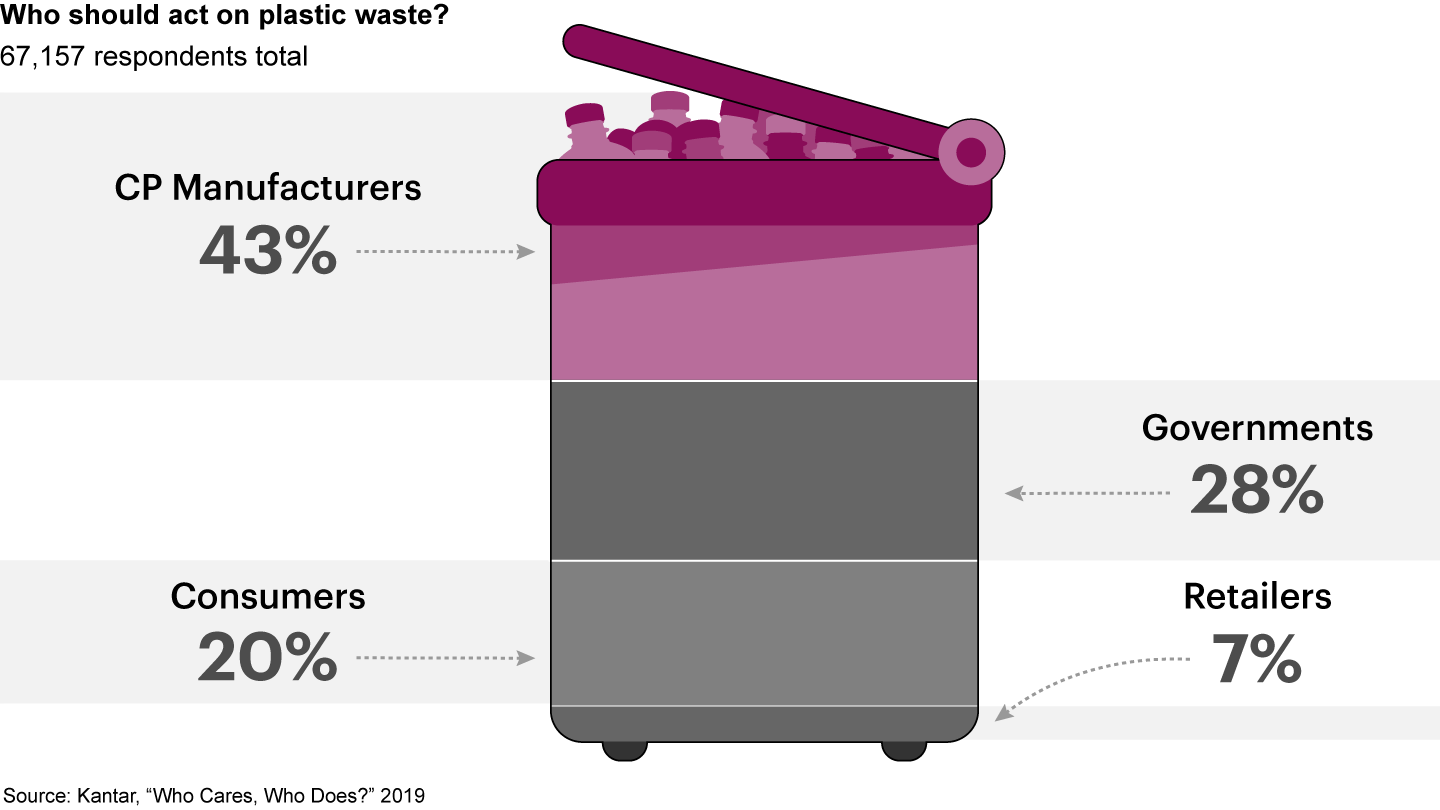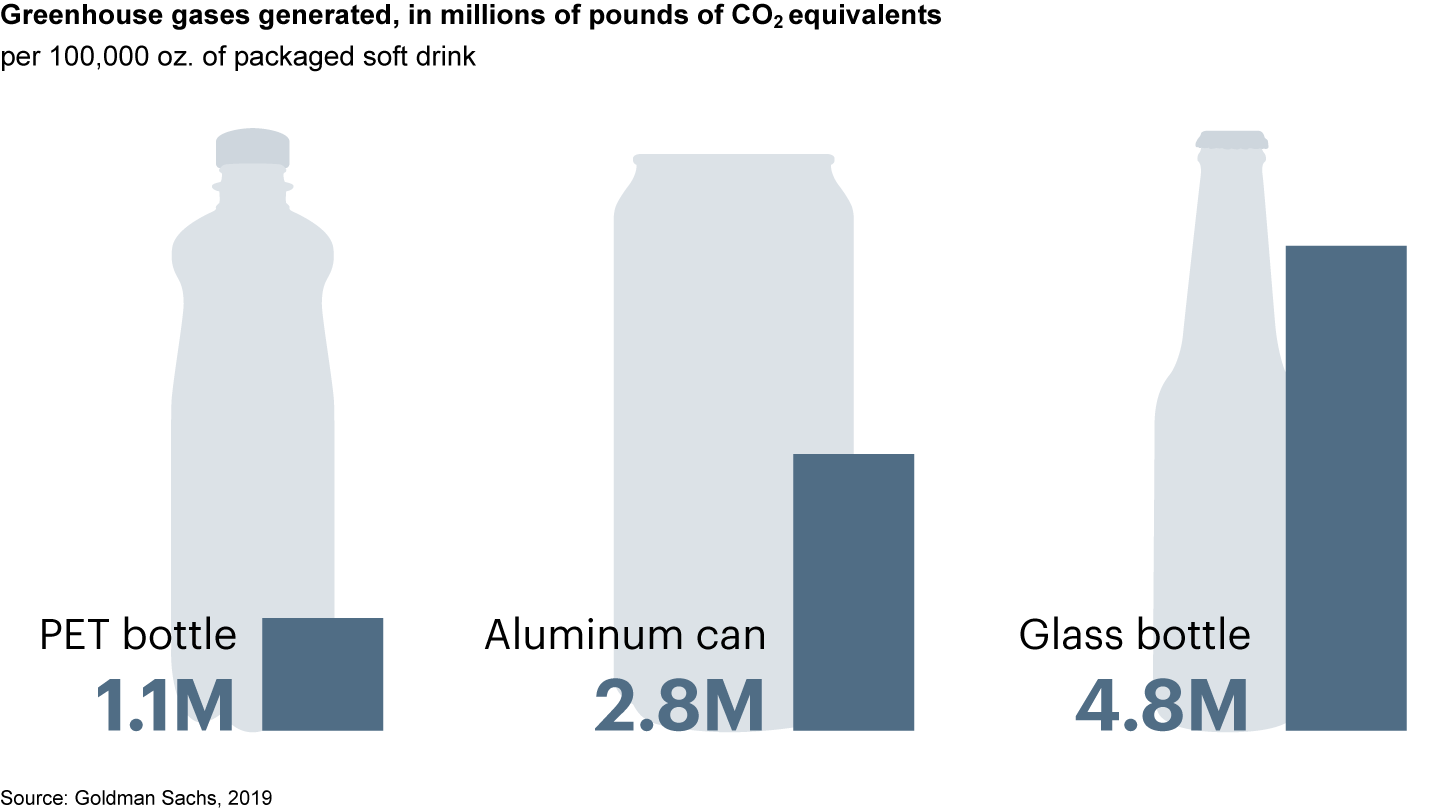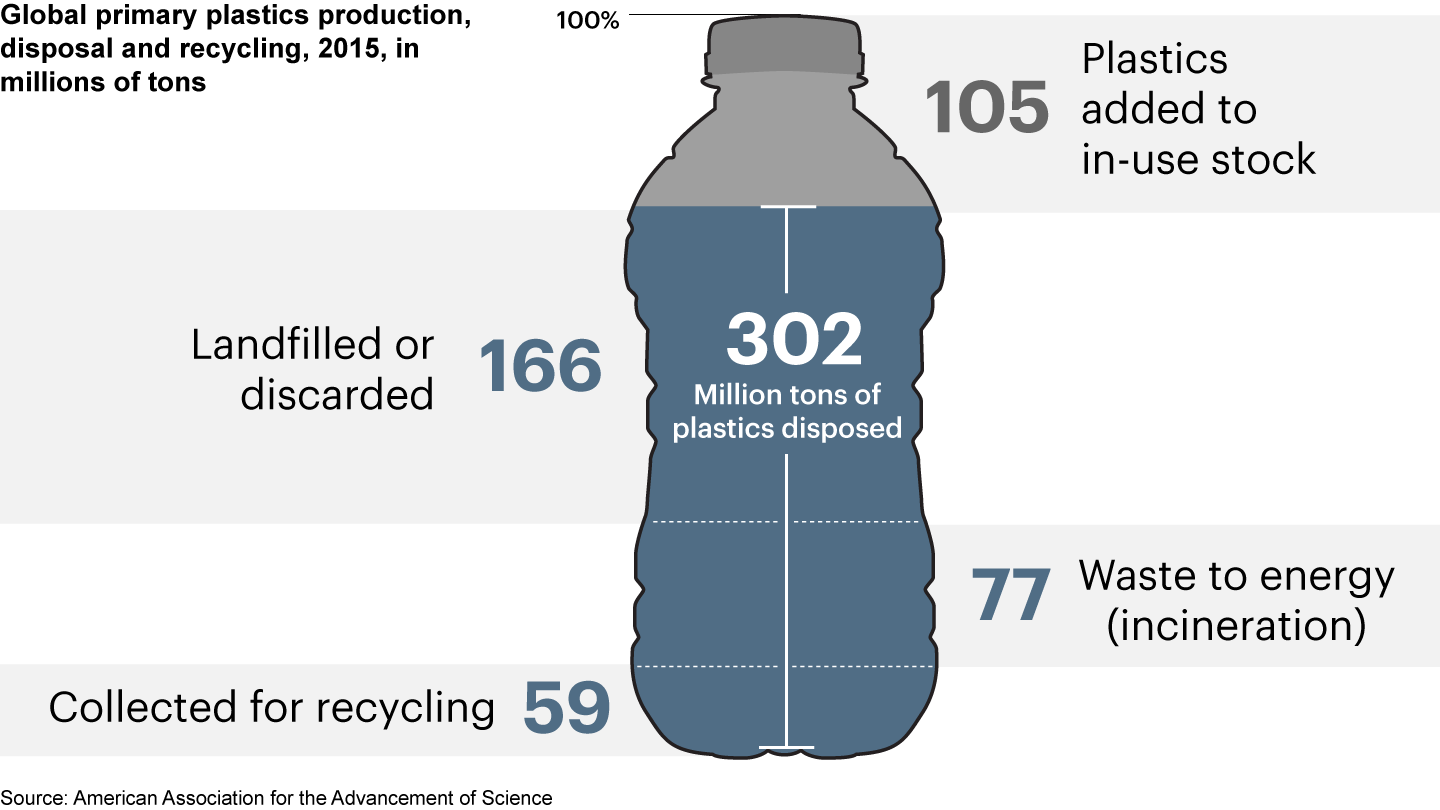Etude

En Bref
- With consumer plastics in the firing line, consumer products and retail executives are grappling with ways to address mounting regulations and changing consumer sentiments.
- As they develop solutions to reduce, reuse and recycle consumer plastics, or reinvent products and value chains, companies find that challenges often inhibit successes. They may commit to using recycled packaging materials, for example, but there is a shortage—and only 45% of consumer waste is recycled or used as waste-to-energy. Or they may commit to switching away from plastics, but some alternative materials are significantly worse than plastics when you look at the total carbon emissions footprint.
- Companies that emerge as leaders will be those that stay close to their consumers’ needs while also forging partnerships to accelerate their solutions.
Plastic beverage containers, candy wrappers, straws, shampoo bottles and shopping bags make their way into our oceans. Governments impose bans. Consumer goods companies and retailers whose businesses depend on plastics are under fire. They commit to using recycled plastic, or they try to find alternative materials. Still, the bad news keeps coming: new regulations from game-changers like China, new predictions of the imminent moment when plastic waste will outweigh fish in the sea, new reports that waste isn’t the only problem but that microplastics in everything from toothpaste to skincare products wash down the drain and also cause environmental problems.
Is the consumer plastics era coming to an end?
It’s not so simple. Arguments in favor of plastics are persuasive. PET bottles are 16% less costly than glass bottles to produce. And plastics often score well on other environmental factors—producing glass emits four times more greenhouse gases than plastic, for example. Plastic’s impermeable barrier is invaluable for reducing food waste, helping with emissions, land use and food access concerns. Strip the sheath of plastic from a cucumber and see how long it stays fresh in transit.
The tension between plastics’ benefits and ills makes it difficult for executives to plot the best path forward. In the past, it was the default material. Now, the already high stakes for solving the consumer plastics puzzle are getting bigger. Consider that the number of countries banning or taxing single-use plastics such as retail shopping bags has risen quickly in the last three years to total 127 countries at last count, with more countries and more products not far behind. Executives feel a sense of urgency to act.
Some consumer products companies are making bold pledges but are likely to run into challenges. For example, Nestlé is investing more than $2 billion to shift to food-grade recycled plastics in its packaging. Yet, the demand for recycled plastic is growing faster than supply. Therefore, prices are rising. Other companies commit to drastic changes in packaging formulation, only to discover that it takes longer than anticipated to develop nonplastic alternatives.
As they encounter such obstacles, more executives are accepting plastics sustainability for what it is—an existential issue. In bottled water, for example, companies that make no significant changes to their business model to address plastic concerns could watch their earnings before interest and taxes (EBIT) margins drop significantly. Approximately 60% of plastic beverage bottles globally are used for bottled water. Bottled water consumption has more than doubled in the US since 2003. If moves such as banning bottles and installing refill fountains take demand back to even 2012 levels, profits could reduce by nearly 15%, according to Bain estimates.
The Plastic Era endures
Despite awareness of the many challenges with consumer plastics, the market continues to expand. Globally, as much as 400 million tons of primary plastic (manufactured from virgin material) is produced each year, with packaging as the largest application. The global plastics market is growing by an annual 3%, spurred not only by packaging but by construction and automotive applications as well.
And the more consumer plastic that’s produced, the more potential for waste. Annually, primary plastics disposed as waste now equals three-quarters of global production, with packaging and consumer goods accounting for almost 60% of that sum (see Figure 1).


As governments and consumers demand that companies use less plastic, many are responding—with some of the biggest names setting the pace. Delta Air Lines has removed single-use straws, utensils and wraps from its aircraft. Accor has pledged to remove all single-use plastic items in guest experience from its hotels. Costco is significantly reducing bottle waste and using recycled material for its Kirkland private label products. Among Danone’s many environmental efforts, the company has pledged that in Indonesia, its Aqua mineral water brand will remove more plastic from the environment than it uses by 2025.
Such moves resonate with consumers. In Europe, 52% have already switched brands or products based on packaging, and an equal percentage in the UK favor taxing all plastic packaging of food products. Roughly 38% of Americans say they would be more likely to buy produce from plastic-free supermarkets. And 43% say consumer products companies should bear the responsibility of acting on plastic waste—only 28% feel it is the responsibility of government (see Figure 2).


A confounding array of solutions
Despite the commitments and initial progress, plastics leave many executives perplexed. For one thing, there is not always enough supply of recycled plastic. Or companies using recycled materials, for example, face criticism in parallel for not promoting bottle deposits. What is not widely known is that some alternative solutions, like glass or aluminum, actually exacerbate other problems, such as carbon emissions (see Figure 3). Indeed, most decision makers are discovering just how complicated it is to satisfy consumer expectations, deliver for the environment and maintain shareholder returns. They know the menu of solutions. And they are coming face-to-face with the challenges.


Let’s look at the delicate balance in the four Rs of consumer plastics (see Figure 4).
Reduce and replace. This may be the most obvious win: Simply get rid of unnecessary plastics. Some companies now design-to-value in a way that cuts down on plastic packaging—thereby reducing costs and increasing margins—while meeting customer demands. Nestlé’s Poland Spring redesigned its packaging material into an “Eco-Shape” that includes almost 37% less plastic resin. Unilever reformulated Omo laundry detergent into a concentration that requires less packaging. Yet, there is much more to be done. While companies are taking these and other steps to reduce packaging, too many products still arrive in too much plastic. And companies are rightly wary of stripping out plastic where it can cause other problems. Just think of that shrink-wrapped cucumber that would otherwise spoil much more quickly.


Another approach is to replace plastic with other materials. Among the most innovative: The Glenlivet in whiskey pods made of Notpla, a seaweed- and plant-based material that biodegrades in four to six weeks if you don’t eat it first (it is edible); and the latest demo product from Carlsberg, a paper bottle. Meanwhile, Dasani water now comes in aluminum cans and Oui yogurt in glass. While these are seemingly constructive steps, some of those materials are significantly worse than plastics when you look at the total carbon emissions footprint. Those materials are just not on the firing line. Companies should focus only on options that are actually better than plastic for the planet.
Recycle. Many consumer goods companies and retailers are betting that plastics will win in the long term, if only the waste problem can be solved. Given this, they are focusing heavily on making their products and packaging recyclable, ensuring that used plastic is recycled, and then putting recycled materials back into their products and packaging. While these may be the right moves, they come with hitches. For starters, while consumers overwhelmingly support recycling, the reality is that only 45% of consumer plastic waste is recycled or used as waste-to-energy (see Figure 5). Seriously improving recycling means changing consumer behavior through education and partnerships across the value chain, something big brands and retailers will have to address if they want plastics to re-earn its place.


In addition to the recycled plastic shortage and the rising prices, a host of related complexities are confronting consumer products and retailing executives. For example, the value of recycling various plastics is sometimes less than the cost to recycle. The technology for sorting and recycling all plastics in an inexpensive way is still in its infancy. Meanwhile, the combination of polymer types and additives leads to thousands of variations with impeded recyclability. While costs are improving as companies gain experience, early movers need to consider a complicated equation.
Everybody around the world needs to tackle recycling, yet companies must focus on different things in different regions, leading to a complex portfolio of actions to manage. In many developing markets, for example, lack of infrastructure is the first priority. Surprisingly this is also the case in some developed markets. In Australia, for instance, the waste management infrastructure lacks the capacity to process all recyclable types of plastics. Yet in other areas the focus has to be more on changing consumer behaviors so people take advantage of the infrastructure that’s there.
Reinvent. Some of the most exciting developments come as companies look to reinvent their products to deal with the plastics conundrum. Unilever’s toothpaste tablets in a reusable package replaces plastic tubes. Procter & Gamble’s soap swatches become cleaning products such as hand soap, shampoo or laundry detergent only when the consumer adds water. They come in biodegradable packaging that takes up 70% less space. Because they contain no water in the package, their production removes 80% of the weight generated by traditional cleaning products and 75% of emissions in transportation.
As they convert their sustainability ambitions into product portfolio choices, some companies are looking for ways to both reduce costs with redesigned packaging or reformulated products and boost revenues through premiumization. However, the reality is that too many consumer goods companies have cut back dramatically on investing in R&D to deliver such innovation. Despite the critical need, they unintentionally cede development of new offerings to start-up insurgent brands. Nearly three-quarters of the top consumer goods companies reduced their total innovation and research and development (R&D) spending from 2006 to 2017. Moreover, the failure rate for consumer goods innovation is staggeringly high at 80% to 85%.
Approaches that are more radical involve reinventing the value chain to eliminate the need for much, if any, packaging at all. Think Loop’s delivery of household goods and food in glass and metal containers that can be reused hundreds of times—like Häagen-Dazs ice cream delivered in attractive stainless steel containers. Think SodaStream’s at-home sparkling water maker, which reduces demand for PET water bottles. Think Evian’s home water appliance, which features a collapsible “bubble” that is made of 100% recycled plastic, is 100% recyclable and uses 66% less plastic than a 1.5-liter Evian bottle. Such solutions circumvent the plastics problem, but come with a big challenge for established companies: They require massive changes to existing operations.
Two stakeholders you cannot do without
As companies pursue ways to tackle the consumer plastics puzzle, and grapple with the challenges, they need to consider this basic fact of life: Solving plastics is bigger than any one company. The most successful will heavily rely on the help of two critical stakeholders: consumers and collaborators.
Consumers are at the heart of this movement. In some ways, consumers are both part of the problem and part of the solution. They’re part of the problem because they are not consistent about what they say (they care about plastics) and what they do (they don’t recycle). They’re part of the solution because they do reward companies that take plastics sustainability seriously.
Companies that are actively defining their plastics sustainability agenda and getting ahead of consumer sentiment are winning over those consumers. For example, to understand what underpins a consumer’s perception of value, we identified 30 fundamental types of value across four categories (functional, emotional, life changing and social impact), which we call the Elements of Value® (see Figure 6 and the HBR article “The Elements of Value”). Through their plastics sustainability efforts, companies contribute to delivering the highest-order element of “self-transcendence.” Brands that score the best on the self-transcendence element grew revenues by an annual 23% from 2015 to 2018, significantly outpacing the average. The finding demonstrates just how much consumers value this social-impact Element of Value. Based on such findings, the best companies can use the plastics puzzle as a way to engage more deeply with consumers—to understand them better and deliver what they value.


No company can solve this problem on its own. Success also requires an openness to collaboration, whether with another company, a proprietary ecosystem or the full industry. For example, to help Australia deal with its recycling shortfall, Coca-Cola Amatil is teaming with the French waste-management company Veolia to build a plastic-recycling plant in the country.
Amazon works with consumer goods companies like Procter & Gamble to box products in Certified Frustration-Free Packaging, which reduces the overall amount of packing materials used. When Amazon challenged P&G to redesign its traditional plastic detergent bottle for e-commerce, the consumer goods company developed new packaging and a concentrated formula. The resulting Tide Eco-Box is smaller and lightweight for e-commerce and requires no secondary packaging. It uses 60% less plastic and 30% less water.
Industry groups are playing a big role, too. For example, the Alliance to End Plastic Waste teams consumer goods companies with chemical manufacturers and others in the plastics value chain on infrastructure, education and engagement, innovation and clean-up efforts.
How to get started
For some companies, finding the right partner will be the appropriate first step for solving the consumer plastics puzzle. Others will need to step back and approach it from a strategic, brand-by-brand perspective. Others will be required to tackle it as an operational challenge. Because the answer is different for each company, success begins by taking stock of where you are. This isn’t necessarily as easy as it sounds. It could involve everything from a “plastic footprinting” exercise to see just how much you’ve got in your business, to a more detailed review of the types of plastics and applications, to a good understanding of consumer and customer requirements to take into account—while examining the moves your peers (not just your competitors) are making.
For consumer goods companies, for example, a practical approach is to review the brands in your portfolio and use that to identify where to start. Brands that already have more “purpose” elements to be enhanced or protected are the first ones to focus on. Identify solutions for the brand, usually starting in one geography, and then see what can scale—either beyond that brand in the same region or for that brand into other regions, reflecting on the different regulations and recycling collection systems. For the rest of the brand portfolio where purpose elements are less central, employ your next design-to-value program to reduce and replace plastic.
Retailers will have to come at it differently. They may use a category lens overlaid with considerations around private label vs. branded products to review product-level actions. On the back end, they will need to wrestle with operational questions around collection, sorting and ultimately recycling. Overall, they will want to see how their brand promise associated with sustainability ties with their actions on the plastic front. They will want to pursue partnerships and collaborations as key elements of the solution.
As you consider your starting point and your options, think like an activist. It is an invaluable way to assess your proposed moves and understand where your vulnerabilities are. But decide like a businessperson, gauging the net impact of your actions with a fact-based eye. And keep your sense of urgency. Whether you decide to build plastic sustainability into all innovation or reinvent a value chain, remember that speed is as important as rigorous preparation. When it comes to grappling with the consumer plastics puzzle, there’s no option but to lean in.
Abhijit Prabhu is a Bain & Company partner based in Boston. Jenny Davis-Peccoud and Jean-Charles van den Branden are coleaders of the firm’s Sustainability and Corporate Responsibility practice. Jenny is based in Amsterdam, and Jean-Charles in Brussels. Gerry Mattios is a Bain expert vice president based in Singapore.
Elements of Value® is a registered trademark of Bain & Company, Inc.